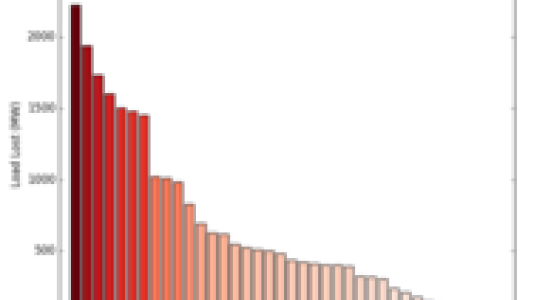
The devastating effects of the hurricanes that hit the United States this summer have highlighted the importance of protecting critical infrastructure. Ideally, system operators would like to prepare for all possible disruptions. In reality, however, the complexity of infrastructure systems and their interconnected components makes such an action both technically and financially infeasible. Therefore, a primary goal should be to identify and prioritize the most critical contingencies affecting infrastructure systems.
To achieve this goal, researchers at Argonne National Laboratory have developed an optimization framework that can identify the highest-consequence failure points within critical infrastructure systems. Two important challenges were addressed: why and where systems fail.
Interdependencies among critical infrastructure may increase risk. Using an example of interactions between electric power and natural gas systems in a southern U.S. state, the researchers showed that a break in a major interstate transmission line supplying natural gas to the state would disrupt fuel delivery to many gas-fired power plants in the state, leading to a statewide electricity outage. But even assuming that three small natural gas-processing plants in one area would have to curtail operations, the study showed that gas customers in the state would see no notable impact because the combined output from those plants would be small relative to the total load.
Infrastructure fails in many different ways with varying consequences. Using an example of an electric power system with three transmission corridors, the researchers showed how disruption of power in Corridor 1 could have greater consequences than would the disruption of power in Corridor 2; thus, Corridor 1 system infrastructure would merit higher priority in developing a protection system.
“Some failures will generate significant consequences at the system or regional level, whereas effects from other failures remain local, while still others have little to no effect on the overall service provided,” said Kibaek Kim, an assistant computational scientist in Argonne’s Mathematics and Computer Science Division.
A key component of the new framework developed by the Argonne team is an optimization algorithm describing the physical behavior of a system such as a power network. The algorithm creates an initial set of disturbances and a control set of actions that might be affected by a disruption. Worst-case contingency analysis is used to find a disruption that causes maximum damage to the system. The algorithm then recursively restricts the disturbance set by iteratively adding linear inequalities to the worst-case interdiction problem.
The success of this algorithm was demonstrated in a test of the California Independent System Operator (CAISO) interconnected with the Western Electricity Coordinating Council (WECC). The test system consisted of 225 buses, 375 transmission lines, 135 generation units, and 40 loads. The algorithm was run on “Blues,” a 350-node high-performance computing cluster at Argonne, to detect the 100 most critical substations in the system. In this test case, a total of 36 substations resulted in significant load loss and failures; the other substations did not cause any load loss.
The new algorithmic approach has several advantages. It is generic and thus is applicable to any infrastructure. It is extensible: additional constraints such as generation cost or repair time of the failure components can be added. Moreover, it can operate at the system level or the interdependent system-of-systems level. The Argonne team is currently extending the approach to alternating current power system and gas-electric interconnected systems, which is partially supported by the DOE Office of Electricity Delivery and Energy Reliability and the Argonne Resilient Infrastructure Initiative.
“Government analysts and infrastructure owners and operators can incorporate our prioritization framework into their infrastructure security and resilience programs and use the information to protect the highest-consequence failure points within their infrastructure systems,” said Kim.
The results were reported at the Tenth Annual Homeland Defense & Security Education Summit was held in March 2017, in Arlington, Virginia. For more information see D. Verner, K. Kim, and F. Petit, “Incorporating Prioritization in Critical Infrastructure Security and Resilience Programs,” http://www.mcs.anl.gov/papers/P7050-0517.pdf. The work has been selected as a best paper for Homeland Security Affairs.